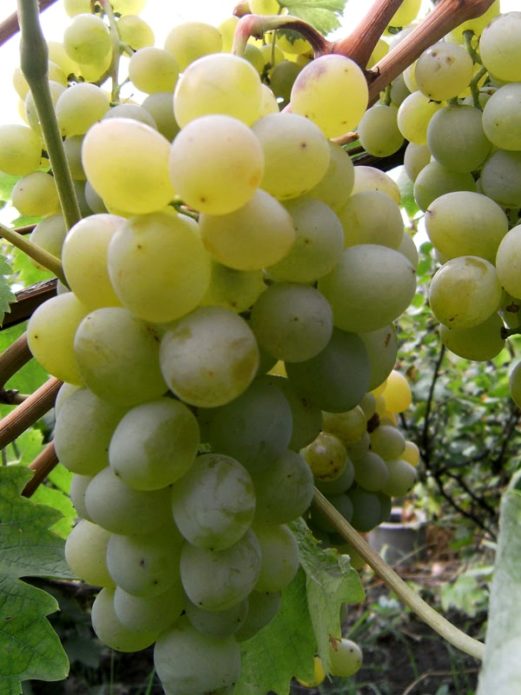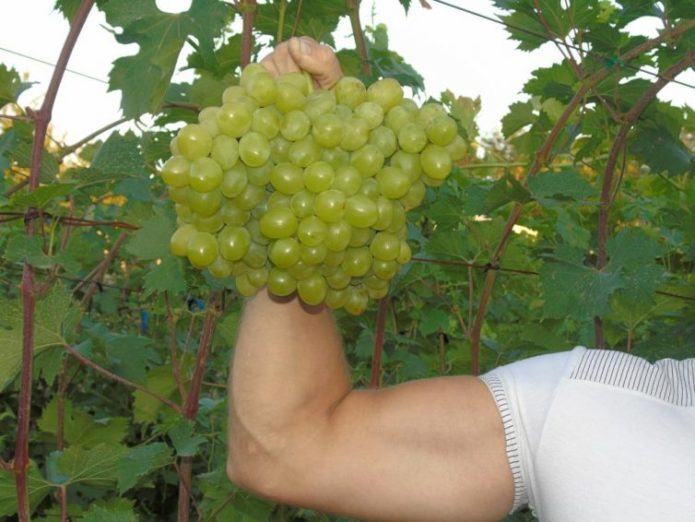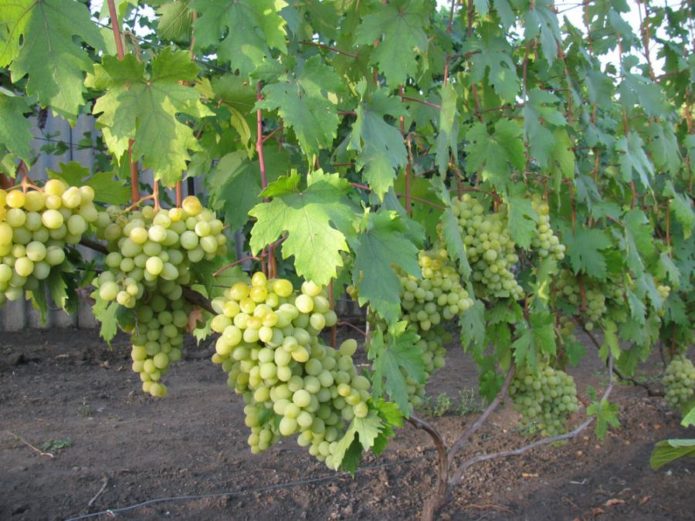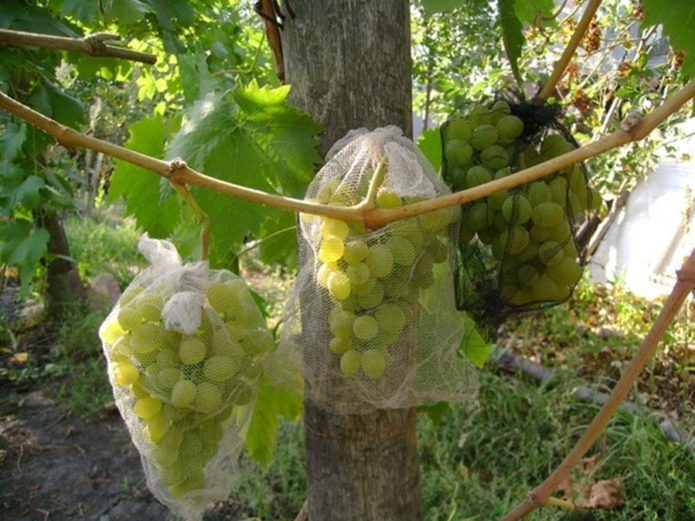There is nothing perfect in the world, but there is something that strives to become so. Among the grape varieties, there is no best in everything, but there are leaders in most indicators. One of these leaders is the Valyok variety - a very early grape with large tasty berries growing on frost-resistant bushes. This variety is capable of bearing fruit in almost any climate, its cultivation is subject to not the most experienced winegrowers.
Content
Breeding history, description and characteristics of the Valyok grape variety
Valyok grapes were bred by the Ukrainian amateur breeder Nikolai Pavlovich Vishnevetsky. For more than 30 years he has been engaged in the selection of grape varieties: first on his small plot in the Kirovograd region, and since 2013 - near Kiev. As the enthusiast himself says, he began these works from despair, from the desire to have ideal varieties, but he could not find those. It is these young people's aspirations for the ideal that drive progress.
To date, N.P. Vishnevetsky has created about two dozen new varieties, he gave all of them the names of close people.
Its grapes are used not only by amateurs, but also by professionals. He creates grape varieties specifically for certain climatic conditions, as a result of which they are known far from only in Ukraine. Each variety has its own main purpose, it is best grown in a particular climate, but they are all highly resistant to diseases.
Valyok grape is the pride of the breeder, he is his favorite. The climatic conditions of the northern regions of Ukraine and, consequently, the regions of the Center of Russia similar to them are most suitable for growing this variety. But this does not mean that Valyok will not grow further south or north. With some amendments to agricultural technology, of course, there will be. This variety was appreciated by Crimean winegrowers, and then by enthusiasts from many regions of Ukraine and Russia.
Valyok is bred on the basis of excellent grape varieties Kesha 1 (aka Talisman), Zvezdny and Rizamat. It is distinguished by a very early ripening period: 105 days pass from the opening of the first buds to the readiness of the crop. The landmark is a widespread variety of Arcadia: Valyok ripens a week or a week and a half earlier. In the south, the crop can be harvested in early August, in the middle lane - two weeks later.
The bushes of this grape are very large, the vine ripens almost 100%. Cuttings take root very well and this is the main method of reproduction. Not all rootstocks are successful in grafting, and the quality of grafted plants is worse than that of own-rooted ones. Frost resistance is slightly higher than average: the bushes can withstand temperatures up to -24 without shelter aboutC. High disease resistance: Valyok is practically not affected by either gray rot or fungal diseases characteristic of grapes.
The first berries can be tasted already in the second year after planting, and after another year the variety enters full fruiting. Over time, the yield increases rapidly and becomes very high.Flowering lasts about 10 days, and the flowers are bisexual, pollinators are not required for the variety. On the contrary, Valyok himself is an excellent pollinator for most grape varieties blooming at the same time. 2-3 clusters are formed on each shoot. Subject to correct agricultural techniques, the yield of an adult bush reaches 30 kg.
The bunches are very large, reaching a mass of 2.5 kg. The average weight is, of course, lower, but still hovers around 1500 g. They are very densely packed with berries. Bunches are especially large in the case of using crop rationing, when no more than one specimen is left on the shoot. The bunches have a high presentation, are well transported over long distances.
The berries are large, slightly oval, about 3 x 2.5 cm in size, weighing 10–15 g. Color - rich yellow, dense pulp consistency, fleshy. The skin is soft, does not interfere with the use of berries. A peculiarity of the taste of berries is considered to be a pleasant nutmeg shade and a pear aftertaste. The berries are sweet, the sugar content of the juice is about 18%. Ripe berries can hang on the bushes for a long time if you take care of protection from flying robbers - wasps, hornets and birds. The use of the harvest is universal, but, first of all, it is table grapes, therefore, berries that ripen very early, of course, are mainly consumed fresh.
Video: Valyok grape harvest on the bushes
Features of planting and cultivation of the Valyok grape variety
Agrotechnology of Valyok grapes differs little from the generally accepted one for the cultivation of most similar varieties.
Landing
When planting Valyok grapes, remember that it grows in the form of a very tall bush, and leave more living space for it. Otherwise, the planting does not differ significantly from most other table grape varieties. With a little experience, you can buy not a sapling at all, but only a cutting and grow a seedling yourself at home. Experts do not recommend planting Valyok on other bush.
In the southern regions, grapes can be planted in autumn and spring, but in the middle lane, autumn planting is quite risky, it is better to do this in April. Like any other grape, it is better to plant Valek near the wall of the house, which protects the bush from cold winds. However, at least two meters must be left to the foundation. When planting several bushes, the distance between them requires solid, at least three meters.
The roll is relatively picky about the composition of the soil. It works best on light loams with a small amount of black soil. Even on sand, it will grow well, but the clay needs to be seriously corrected, in advance by adding a large amount of sand and, if any, peat. In clay soils and humus are added above the usual rate. Simultaneously with the preparation of the landing pit, it is necessary to build a strong and high trellis. Of course, growth will have to be limited by pruning, but all the same, the bush will turn out to be large, and together with the harvest, it will be heavy.
The pit should be large: no less than 80 cm in all dimensions. Drainage at the bottom of the pit is required on all types of soils, except frankly sandy. Stagnant water can lead to root rot. However, for the convenience of watering, it is advisable to lay a vertical irrigation pipe with a diameter of several centimeters directly to the roots. Part of the removed upper soil layer is placed in the lower half of the pit, after thoroughly mixing it with fertilizers: one and a half buckets of humus, a couple of liters of wood ash, 150-200 g of nitrophoska. At the top of the pit, there is a clean, fertile soil.
After the hole is ripe, a spacious hole is dug in it so that the grapes are planted deeply, but the roots cannot be dipped in fertilizers. Planting is carried out in the usual way, two buds are left on the surface, the seedling is well watered, the soil is mulched.In the first year, the grapes are watered weekly, preferably with water heated in the sun.
Care
Caring for adult bushes consists of watering, feeding, forming a bush, and preventive spraying. In the middle lane, it is also necessary to shelter the vine for the winter. After watering, the soil under the young bushes is loosened, mulched, and weeds are removed. Adult grapes manage weeds on their own. Watering frequency depends on the weather; the greatest amount of moisture is required for the grapes during the period of intensive growth of berries; 2-3 weeks before the harvest ripens, it is not watered. Winter watering is also required.
The bushes are fed annually. Be sure to use wood ash, scattering it in a thin layer around the grapes in the spring before watering. Mineral fertilizers are most effective for foliar feeding: the leaves are sprayed with any complete fertilizer before flowering and with the start of berry growth. Once every two years, organic matter is introduced, burying 1-2 buckets of humus or compost under the bush.
The roll is resistant to diseases, so just one spraying in early spring or on the "green cone" may be enough. Dormant vines can be treated with iron vitriol, awakened with Bordeaux mixture. The invasion of wasps requires more care: the fight against them is mandatory. Sweet baits with insecticides help to some extent, but most growers wrap the most valuable bunches in special nets.
The bushes of this grape are very large, so growth has to be held back by pruning, and what is left is periodically well tied to strong trellises. Spring pruning is carried out to a minimum: obviously unnecessary and dead shoots are removed. The main work falls on the summer, when weekly it is necessary to inspect the bush and remove everything that has grown in the wrong place, even at the stage of small green shoots.
The bunches have to be “combed”, although not all growers do this: they claim that they ripen and so. One has only to remove the leaves that cover the berries from the sun. True, here, too, not everything is so simple: breaking out the covering leaves opens access to the fruits for birds, so a kind of compromise is needed.
The main pruning occurs in autumn, it is carried out after the foliage has fallen. Since the bunches of this variety are laid even in the lower part of the shoots, it makes no sense to leave more than 6-8 eyes on the vine. Autumn pruning is usually accompanied by both sub-winter watering and grape shelter for the winter. In the southern regions, Valyok is not even always removed from the supports, in other climatic zones it requires light shelter: pine or spruce branches are enough.
Advantages and disadvantages of the variety in comparison with similar
In recent years, many varieties of table grapes with a very early ripening period have appeared. These are, for example, Libya, Long-awaited, Sensation, etc. All of them are close to each other in terms of their set of parameters, standing out either by the appearance of the bunches and berries, or by their unique taste and aroma, or by increased resistance to frost and diseases. It is probably difficult to name the best one: each grower will have his own opinion.
In this long row, Valek is far from an outsider, he has practically no flaws, and the pear tint in the taste distinguishes his berries from others. The obvious advantages of the variety are:
- increased frost resistance;
- very high resistance to disease;
- very early ripening of berries;
- very large and beautiful bunches;
- good productivity;
- interesting taste of berries;
- excellent transportability of the crop;
- buncation of flowers and the ability to act as an excellent pollinator.
The disadvantages of the variety include:
- damage to berries by wasps;
- poor compatibility with many rootstocks;
- too much growth of the bushes.
This variety has spread throughout Ukraine and is grown in many regions of our country, gardeners hunt for it, which indicates that it is one of the best.
Video: grower about the Valyok variety
Reviews
Smallish, the bunches are too dense, if you sell yourself, then the buyer can be smartly offered, but for wholesalers it will not be interesting. And about the vine, if there is nothing special in the form, and the vine is not in short supply. For connoisseurs of nutmeg taste Valek will be interesting, for the market it is not, I just sell grapes for a long time, "chuyka".
Valka has medium berries with a good load of 10 -12g. But I saw more with good care. Especially if you thin out the bunch. I agree with many that Valka has dense clusters. But the berries do not crack and hang on the bush for a long time. Some bunches grew to frost in October, and after lying until December, they did not lose their taste.
Valk's bunch is mostly dense, but, as a rule, the berry does not choke, does not crack, does not rot. The shape is not bad, if you still work with the HA to stretch the brush, I think there may be no problems with the density of the bunches. Valek is beautiful and delicious.
The hybrid form Valyok has been growing in our (Belgorodsky District, MK Tavrovo 2) for the third year already. Despite last year's frosts, the kidneys woke up 100%. Pollination went well, one might even say that it was dusty. Therefore, I had to work with the bunches with scissors and removed one fifth of the berries. I want to say that despite the fact that gf. requires a little attention, but I'm very happy with it! Namely, a very fruitful, unusual nutmeg with pear tones. I had no problems with the implementation, it left at a high price.
In my opinion, nutmegs have a richer TASTE. When Valek is in good condition, it has some kind of its own, special nutmeg, its own aftertaste. They write that this is a duchess. Maybe it depends on the soil? It somehow reminds me of floral tones ... Tason is about the same in taste ... And Livia, of course, but here Muscat is kind of more complicated and even more interesting ...
Valyok grape is one of the best among the very early varieties of table grapes. It is distinguished by very large clusters, high frost resistance and disease resistance. The popularity of the variety is constantly growing, it is planted in various climatic conditions. It can be recommended for both industrial viticulture and private orchards.






